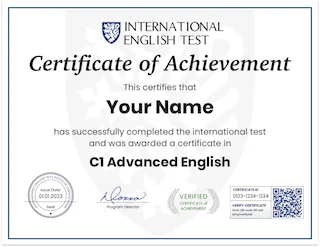Want to use different scary expressions and learn phrases about phobias in English?
A phobia is an overwhelming fear, an anxious response to a specific stimulus. Individuals with a phobia experience fear and tend to actively avoid particular situations, objects, or activities.
For instance, I have a fear of heights, confined spaces, and deep water. Do you have any phobias?
Today, let’s explore the names of ten phobias in English and also delve into some phrases for expressing fear.
What is your English level?
Find out your A1 A2 B1 B2 C1 C2 level of English with our online test and receive your English certificate.
- Gamophobia
Gamophobia is the apprehension of marriage and familial connections in general. Typically, this phobia is more commonly found in men, with women exhibiting lower susceptibility.
The origins of gamophobia are often linked to witnessing the experiences of the older generation. It typically surfaces in early childhood when a child regularly witnesses conflicts between parents or neighbors. At this early age, individuals start to question the value of establishing a family when they could potentially live autonomously, without imposing on others or being reliant on anyone.
Although gamophobia may seem innocuous, it is, in reality, a substantial mental disorder that requires the assistance of an experienced specialist.
- Xenophobia
Xenophobia is the fear, dislike, or intolerance directed at individuals who are unfamiliar, strange, or different. It encompasses a broad spectrum of attitudes and behaviors, with racism being the most extreme form of intolerance towards individuals of other races.
Notably, xenophobia has a contagious aspect: individuals who experience xenophobia may also develop xenophobic sentiments towards other minority groups facing discrimination, as well as towards the majority group.
- Phasmophobia
Phasmophobia is the fear of ghosts. The mere idea that there might be unexplained entities in proximity instills individuals with phasmophobia with fear and apprehension.
The origin of this phobia can be traced back to an exceptionally realistic horror film, the scenes of which become deeply ingrained in one’s memory and gradually evolve into a phobia.
- Bathophobia
Bathophobia is the fear of depths, particularly deep water. Individuals with bathophobia experience a sense that an abyss lies beneath them, often accompanied by symptoms such as panic attacks, emotional agitation, anxiety triggered by thoughts of depth, and fear of becoming entangled in algae.
For instance: I became extremely nervous and agitated when contemplating the depth as we crossed the river.
- Claustrophobia
Claustrophobia, widely recognized as the fear of confined or enclosed spaces, is one of the most prevalent pathological fears, alongside agoraphobia. Individuals experiencing a bout of claustrophobia typically become highly agitated.
- Iatrophobia
Iatrophobia is an irrational fear of doctors, leading individuals afflicted with this phobia to actively avoid visiting medical professionals. In some cases, even doctors themselves may experience this fear, having observed instances of negligence and irresponsibility among their colleagues.
Are you C1 Advanced English?
Get your C1 Advanced English certificate now!
✓ Add your certificate to your resume
⭐ ⭐ ⭐ ⭐ ⭐
- Acrophobia
Acrophobia is the fear of heights, inducing dizziness and potential nausea, even in situations where the elevation is not significant and the individual is in a completely secure environment.
- Agoraphobia
Sure, here’s a paraphrase of the previous response:
Iatrophobia is an irrational fear of doctors, causing individuals with this phobia to actively evade medical appointments. Occasionally, even medical practitioners may grapple with this fear, particularly after witnessing instances of negligence and irresponsibility among their peers.
- Arachnophobia
Arachnophobia, derived from “arachnos” meaning spider and “phobos” meaning fear, is the irrational fear of spiders, and it stands as one of the most prevalent phobias. Surprisingly, statistics reveal that people exhibit more fear towards spiders than other potentially dangerous entities like guns, cars, or airplanes.
Interestingly, individuals with arachnophobia might find images of spiders more terrifying than encountering real spiders. Notably, public figures such as Johnny Depp, Justin Timberlake, Rupert Grint, and Andre Agassi have openly admitted to having arachnophobia.

Phobias arise as a result of some kind of unpleasant experience or event, after which a person begins to have irrational, unexplainable, and uncontrollable fear.
In order to overcome your fear, you need to work to conquer it. If you are afraid of heights, go skydiving. If you are afraid of depth, take up scuba diving.
Just do it gradually. If you can’t overcome your phobia all by yourself, see a specialist.
What is your English level?
Find out your A1 A2 B1 B2 C1 C2 level of English with our online test and receive your English certificate.


